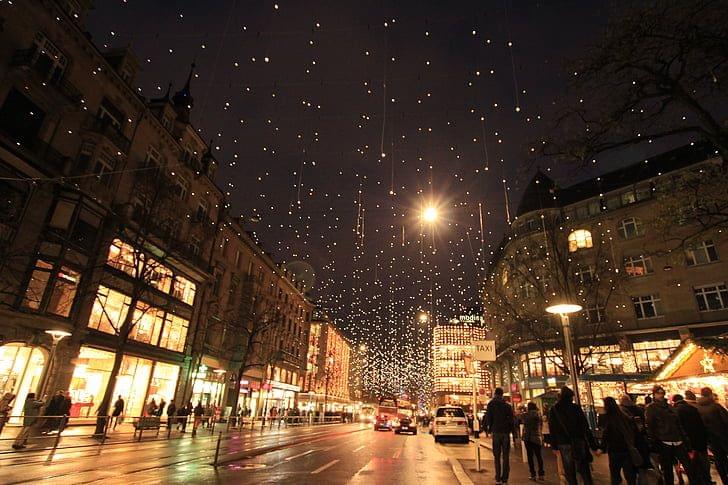
- Home
- Tourism
- Switzerland
- Best Time to Visit Zurich, Switzerland: Complete Month-by-Month Travel Guide
Best Time to Visit Zurich, Switzerland: Complete Month-by-Month Travel Guide

Zurich is the financial hub and the largest city in Switzerland. The city offers year-round appeal and transforms dramatically with each season. The best time to visit Zurich depends on your personal preferences, budget, activities and climatic conditions. Spring and autumn shoulder seasons deliver comfortable temperatures, while summer brings long daylight hours, perfect for lake activities and alpine excursions. This Zurich climate guide breaks down every month to help you choose the best month for your Zurich trip.
Key Takeaways

- April to June and September to October offer the ideal balance of pleasant weather, moderate crowds, and lower prices for visiting Zurich
- Summer (July-August) brings peak tourism, the highest temperatures averaging 24°C (75°F), and premium accommodation rates
- November to March is the cheapest time to visit, with accommodation costs 30-40% lower than peak season, though the weather is cold and rainy
- December stands out as a special winter month thanks to world-class Christmas markets, despite being one of the coldest periods
- Each season serves different traveller types: summer for outdoor enthusiasts, winter for culture seekers, and shoulder seasons for budget-conscious explorers.
Zurich Weather by Season (What to Expect Year-Round)
Peak Season in Zurich (June–August, December): Switzerland in June marks the beginning of the summer season with temperatures ranging between 15-22°C (59-72°F). July brings the warmest weather with longer daylight hours and minimal rainfall. Summers are the Zurich peak season months, and hotel rates surge up to 40-60% above baseline prices.
- Best For: Active travellers planning hiking, cycling, and water sports, festival enthusiasts.
Shoulder Season in Zurich (April–May, September–October): April brings mild weather with temperatures between 9-15°C (48-59°F). The city enjoys comfortable sunshine with warm sunny afternoons, ideal for outdoor activities. Hotels offer better deals with a drop of 20-30% and enjoy shorter queues at attractions. Both seasons see moderate rainfall, so packing layers and a waterproof jacket is essential.
Best For: Travellers seeking a balance of mild weather and fewer crowds, couples seeking romantic settings with blooming gardens and waterfront promenades.
Off-Peak Season in Zurich (November–March): November marks the beginning of the winter season in Switzerland. These months are the cheapest times to visit Zurich as hotels significantly reduce their prices, thereby making luxury stays more accessible. The city experiences cold temperatures below the freezing point, and snow is common, especially in the surrounding Alps.
Best For: Budget travellers, romantic winter experience, Swiss cultural celebrations.
Zurich Festival Calendar – Events and Cultural Highlights

| Season | Key Events |
| Spring | Sechseläuten (April), Zurich Festival (early May) |
| Summer | Street Parade (August), Zurich Film Festival (September) |
| Autumn | Zurich Theatre Spektakel (late August), Knabenschiessen (September) |
| Winter | Christmas Markets (November-December), Silvester New Year celebrations |
Zurich Travel Costs – Budget Breakdown by Season

| Season | Months | Availability of accommodations | Notes |
| Off-Season | January–March, November | Significant discounts on hotels and tours | Lowest prices; fewer crowds |
| Shoulder Season | April–May, September–October | Standard prices but better availability | Best value-to-experience ratio; pleasant weather |
| Peak Season | June–August, December | Premium rates for attractions | Very busy; Christmas markets peak demand in December |
What to Pack for Zurich – Year-Round Packing Tips
Packing for Shoulder Season in Zurich (April–May, September–October)
- Pack layers, including a light jacket and long-sleeve shirts.
- Comfortable walking shoes.
- Bring a compact umbrella as afternoon showers occur frequently.
Packing for Summer in Zurich (June–August)
- Light, breathable clothing.
- Comfortable sandals or walking shoes for city exploration.
- Sunglasses and sunscreen for extended outdoor activities.
Packing for Winter in Zurich (December–February)
- Pack warm winter clothing, including a heavy coat.
- Insulated boots, gloves, and a warm hat.
Conclusion: Planning Your Zurich Trip?
Zurich rewards visitors in every season. From the blossoming lakeside promenades of spring to the glittering Christmas lights of winter, the best time to visit Zurich ultimately depends on your budget and preferences. The shoulder season offers the perfect balance of pleasant weather and fewer crowds, while the winter months wrap the city in festive warmth. Start planning your itinerary with Pickyourtrail’s Zurich Holiday Packages and gain access to our exclusive deals, customised itineraries, hassle-free visa processing and many more.
Frequently Asked Questions About Visiting Zurich
Is Zurich Expensive to Visit Year-Round?
Zurich ranks among Europe's most expensive cities, but costs vary significantly by season. January and November offer the lowest rates, with mid-range hotels 30-40% cheaper than summer months. Shoulder seasons (April-May, September-October) provide moderate pricing that balances cost with good weather. December and summer (June-August) command premium rates, with accommodation costs sometimes doubling compared to off-peak periods. Food and transportation costs remain relatively stable year-round, so accommodation timing offers your best opportunity for savings.
What to Pack for Zurich in the Shoulder Season?
Pack versatile layers for shoulder season visits in April-May or September-October. Include a waterproof jacket, long-sleeve shirts, one warm sweater, and both pants and lighter clothing options. Comfortable walking shoes with good traction are essential for cobblestone streets that can be slippery when wet. Bring a compact umbrella for sudden showers, which occur frequently in these transitional months. Temperatures can range from 10-20°C (50-68°F) in a single day, so the ability to layer up or down proves invaluable.
When Can You Swim in Lake Zurich?
Lake Zurich's public swimming areas (Badis) typically open in mid-May and operate through mid-September, depending on weather conditions. Water temperatures reach comfortable swimming levels (18-22°C/64-72°F) from June through August. Popular swimming spots include Seebad Enge, Strandbad Mythenquai, and Flussbad Oberer Letten. These facilities offer changing rooms, sunbathing areas, and some have lakeside restaurants. Outside official swimming season, only experienced cold-water swimmers use the lake, as temperatures drop significantly in spring and autumn.
How Many Days to Spend in Zurich?
Plan 2-3 days to experience Zurich's core attractions comfortably. This allows time for exploring the Old Town (Altstadt), visiting at least two major museums like Kunsthaus Zürich or the Swiss National Museum, enjoying Lake Zurich's waterfront, and taking a day trip to nearby destinations like Uetliberg or Rhine Falls. If you want to explore multiple alpine destinations or experience specific seasonal events like Christmas markets, extend your stay to 4-5 days. Zurich's compact size and excellent public transportation make it possible to see highlights in just one full day, but this pace doesn't allow for the relaxed exploration that enhances the Swiss experience.
Does Zurich Get Snow in Winter?
Zurich experiences occasional snowfall from December through February, but significant accumulation in the city itself is relatively rare. When snow does fall, it typically melts quickly at the lower elevation where the city sits. The surrounding mountains receive much more snow, which enhances day trip opportunities to ski resorts but rarely disrupts city transportation. Zurich's public transit system handles winter weather extremely well, with trams and buses operating reliably even during snowfall. Plan for cold, often rainy winter conditions rather than expecting a snowy wonderland within the city limits.
Update your location?



